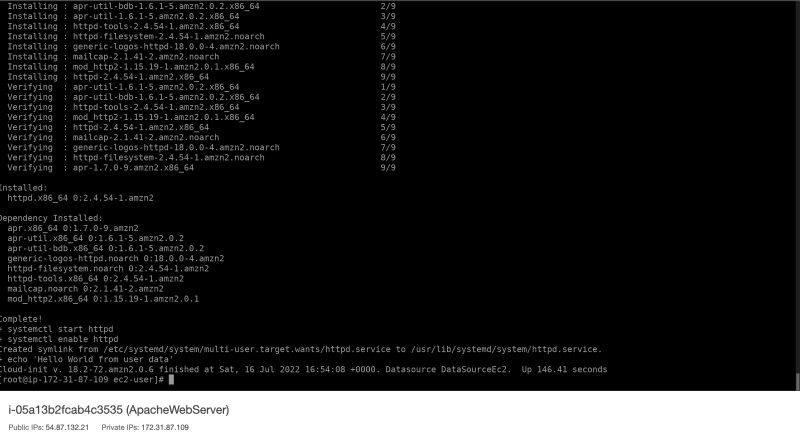In this tutorial I will give you a guided walk-through on how to install an Apache Web Server on an EC2 Linux Instance using EC2 user data. All resources will be provisioned by CloudFormation (IAC). With that being said, let's get straight into it.
Define our parameters to be used in our CloudFormation Stack.
---
Parameters:
AppName:
Type: String
Description: Enter the name of your resource you are creating.
Default: ApacheWebServer
Stage:
Type: String
Description: Enter the staging environment of you resource.
Default: dev
We then define our resources. The resources that we need are, an SSH Key, an EC2 Instance and a Security Group.
Resources:
## Our EC2 SSH Key
SSHKey:
Type: 'AWS::EC2::KeyPair'
Properties:
KeyName: !Join ['-', [!Ref AppName, 'key-pair', !Ref Stage] ]
## EC2 Instance
MyInstance:
Type: AWS::EC2::Instance
Properties:
ImageId: ami-009d6802948d06e52
InstanceType: t2.micro
KeyName: !Ref SSHKey
SecurityGroups:
- !Ref SSHSecurityGroup
# we install our web server with user data
UserData:
Fn::Base64: |
#!/bin/bash -xe
yum update -y
yum install -y httpd
systemctl start httpd
systemctl enable httpd
echo "Hello World from user data" > /var/www/html/index.html
Tags:
- Key: Name
Value: !Ref AppName
- Key: Environment
Value: !Ref Stage
# Our EC2 security group
SSHSecurityGroup:
Type: AWS::EC2::SecurityGroup
Properties:
GroupDescription: SSH and HTTP
SecurityGroupIngress:
- CidrIp: 0.0.0.0/0
FromPort: 22
IpProtocol: tcp
ToPort: 22
- CidrIp: 0.0.0.0/0
FromPort: 80
IpProtocol: tcp
ToPort: 80
Note: The key take away here is the block of code we wrote for user data. We are using "Fn::Base64" followed by a vertical pipe to pass an entire bash script to the instance. The vertical pipe is used so the script can be recognized as one string.
Complete Template File
---
Parameters:
AppName:
Type: String
Description: Enter the name of your resource you are creating.
Default: ApacheWebServer
Stage:
Type: String
Description: Enter the staging environment of you resource.
Default: dev
Resources:
## Our EC2 SSH Key
SSHKey:
Type: 'AWS::EC2::KeyPair'
Properties:
KeyName: !Join ['-', [!Ref AppName, 'key-pair', !Ref Stage] ]
## EC2 Instance
MyInstance:
Type: AWS::EC2::Instance
Properties:
ImageId: ami-009d6802948d06e52
InstanceType: t2.micro
KeyName: !Ref SSHKey
SecurityGroups:
- !Ref SSHSecurityGroup
# we install our web server with user data
UserData:
Fn::Base64: |
#!/bin/bash -xe
yum update -y
yum install -y httpd
systemctl start httpd
systemctl enable httpd
echo "Hello World from user data" > /var/www/html/index.html
Tags:
- Key: Name
Value: !Ref AppName
- Key: Environment
Value: !Ref Stage
# Our EC2 security group
SSHSecurityGroup:
Type: AWS::EC2::SecurityGroup
Properties:
GroupDescription: SSH and HTTP
SecurityGroupIngress:
- CidrIp: 0.0.0.0/0
FromPort: 22
IpProtocol: tcp
ToPort: 22
- CidrIp: 0.0.0.0/0
FromPort: 80
IpProtocol: tcp
ToPort: 80
Upload CloudFormation Stack to the console.
First, navigate to the directory where you have your template file stored. You can use the below terminal command to upload your stack to AWS.
aws cloudformation deploy
--template-file <TEMPLATE NAME>
--stack-name <STACK NAME>
--profile <AWS PROFILE NAME>
If the stack was uploaded successfully, you should see this message "Successfully created/updated stack - ".
Navigate to AWS Console
If you are in the console, go to EC2 Dashboard, you should see the instance you created. Select the instance and click on connect. Connect to the instance using EC2 Instance Connect.
Inspect Cloud Init Logs
Now we are going to inspect the logs to view the scripts that ran when the instance was booted up.
First, we need root privileges. Execute the following command so we can have root privileges in our instance.
sudo su
Second, we're gonna run the command to view the actual log files.
cat /var/log/cloud-init-output.log
Now you should be able to see a complete list of logs from the scripts that were executed.
Lastly, to test that our web server is properly hosting our html web page. You can copy the public DNS of the instance, paste it in your web browser. By doing this you should be able to access the web page we created.
That's it, we successfully provisioned an EC2 instance and installed an Apache Web Server on it using user-data. Now, the last step is to clean up all the resources that were used.
Clean Up Resources
In your terminal execute the following command. Since, we created our resources using CloudFormation by deleting the stack, all resources that were in the stack will be deleted as well.
aws cloudformation delete-stack
--stack-name <STACK NAME>
This was just a small demonstration of what you can accomplish with EC2 user data. Please feel free to explore beyond this tutorial and add extra features.
I do hope this tutorial was useful for you. Stay curious, keep learning, and keep building. Thank you.






Top comments (0)